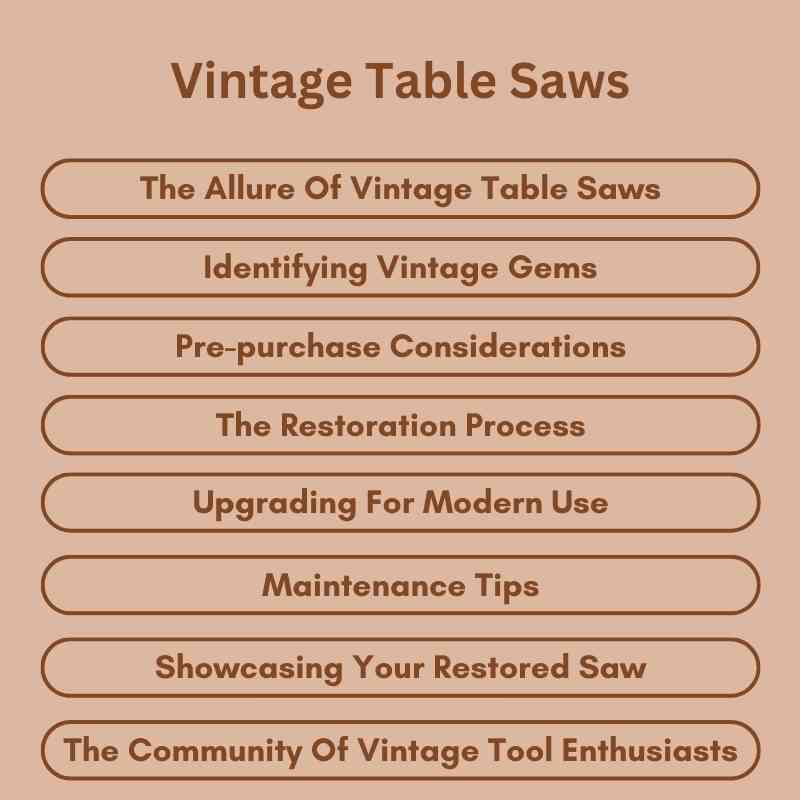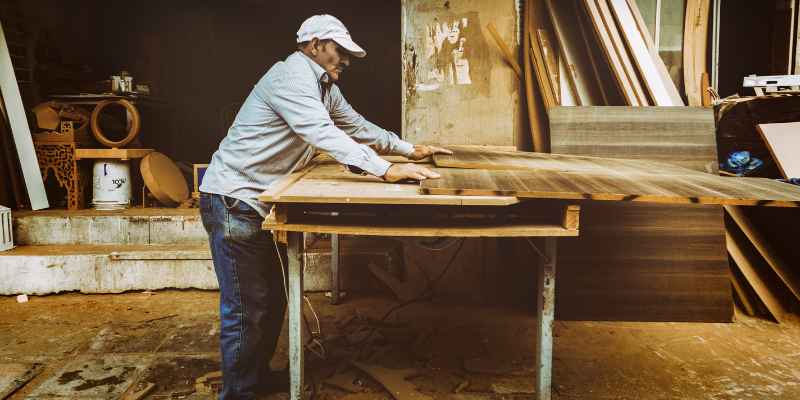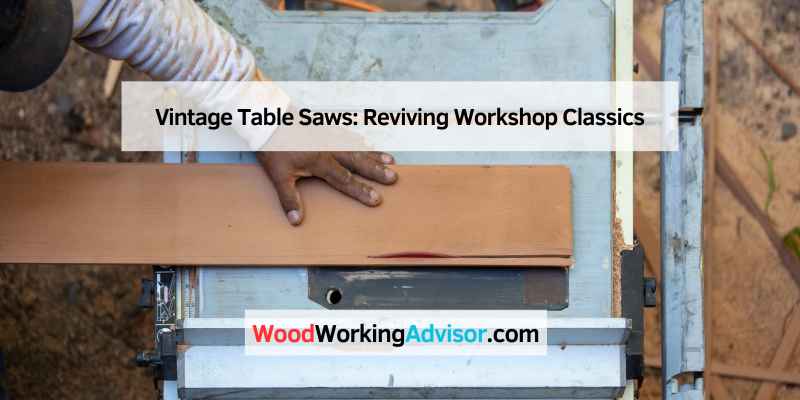Vintage table saws are classic woodworking tools known for their durability and precision. They often feature robust construction and timeless designs that appeal to both collectors and craftsmen.
Vintage table saws have become increasingly popular among woodworking enthusiasts. These machines offer a blend of nostalgia and exceptional performance. Many artisans prefer them for their reliability and ability to produce fine cuts. The craftsmanship of vintage models often surpasses some modern alternatives.
Collectors appreciate the historical significance and unique aesthetics of these saws. Finding a well-maintained vintage table saw can enhance any workshop. These tools not only serve practical purposes but also add character to the workspace. Understanding their features and maintenance can maximize their lifespan and performance. Investing in a vintage table saw can be both a practical and rewarding decision for any woodworker.
The Allure Of Vintage Table Saws
Vintage table saws possess a unique charm. They combine functionality with nostalgia. Many woodworkers appreciate their craftsmanship. These tools tell stories of the past. They evoke memories and inspire creativity.
Why They Stand Out
Vintage table saws stand out for several reasons:
- Quality Craftsmanship: Built to last, many vintage saws feature superior materials.
- Unique Designs: Each model has its own character and style.
- Rich History: Many saws come with stories and heritage.
- Affordability: Often, vintage options cost less than new models.
Timeless Design And Durability
The design of vintage table saws is timeless. Their aesthetics appeal to many collectors. These saws often feature:
| Feature | Description |
|---|---|
| Heavy Cast Iron | Provides stability and reduces vibration. |
| Simple Mechanisms | Easy to repair and maintain. |
| Classic Colors | Often painted in rich, vibrant hues. |
Durability is a key feature. Many saws from decades ago still function well. They can withstand years of heavy use. This quality makes them valuable tools today.

Identifying Vintage Gems
Finding a vintage table saw can be thrilling. These tools hold history and exceptional craftsmanship. Knowing how to identify quality models is essential. Here are some tips to help you spot vintage gems.
Spotting Quality And Craftsmanship
Quality is key in vintage table saws. Look for these features:
- Cast Iron Body: Heavy and durable.
- Precision Machining: Smooth surfaces and tight tolerances.
- Solid Wood Components: Features like fence and table extensions.
Check for brand markings. Well-known brands often used high-quality materials. Inspect the overall condition. Rust, wear, and damage can reduce value.
Popular Models Through The Decades
Certain models stand out over the years. Here are some noteworthy vintage table saws:
| Model | Year | Key Features |
|---|---|---|
| Unisaw | 1939 | Heavy cast iron, high RPM, precise cutting. |
| Delta 10″ Table Saw | 1950s | Portable, solid build, excellent for hobbyists. |
| Rockwell 34-450 | 1970s | Versatile, reliable, and easy to use. |
Research these models for better understanding. Each has unique features that appeal to collectors and users alike.
Pre-purchase Considerations
Buying a vintage table saw can be exciting. These tools often have unique features and charm. Before making a purchase, consider a few important factors. Understanding the condition and where to find these saws is essential.
Assessing Condition And Needs
Before purchasing, assess the condition of the vintage table saw. Here are key points to evaluate:
- Rust: Check for rust on the table and components.
- Blades: Ensure the blades are sharp and in good shape.
- Motor: Inspect the motor for any signs of wear.
- Parts Availability: Research if replacement parts are easy to find.
- Functionality: Test all functions, including adjustments and settings.
Make a list of your specific needs:
- What type of woodworking will you do?
- How often will you use the saw?
- Do you need portability or stationary use?
- What size of wood will you cut?
Where To Find Vintage Table Saws
Finding vintage table saws can be a fun adventure. Here are some great places to search:
| Location | Description |
|---|---|
| Online Marketplaces | Websites like eBay and Craigslist often have listings. |
| Local Auctions | Attend estate sales or auctions for hidden gems. |
| Woodworking Shops | Visit local shops; they may have used tools for sale. |
| Social Media Groups | Join groups dedicated to vintage tools for leads. |
Network with fellow woodworkers. They might know where to find good deals. Always inspect the saw before buying. This ensures you make a wise investment.
The Restoration Process
Restoring a vintage table saw is a rewarding journey. It requires patience, skill, and attention to detail. The process often brings old tools back to life. Following the right steps ensures a successful restoration.
Cleaning And Disassembly
Start with thorough cleaning. Remove dust and grime using:
- Soft brushes
- Compressed air
- Degreaser
Next, carefully disassemble the table saw. Keep track of all parts. Use labeled bags or containers for small pieces. This prevents loss and confusion during reassembly.
Replacing Worn Parts
Inspect all components for wear and damage. Common parts to replace include:
- Blades
- Bearings
- Belts
Quality replacement parts enhance performance. Source parts from trusted suppliers. This ensures compatibility and longevity.
Refinishing Techniques
Refinishing improves appearance and protects the wood. Follow these steps for best results:
- Sand the surface with fine-grit sandpaper.
- Apply a wood conditioner to prepare for staining.
- Choose a stain that matches your desired look.
- Finish with a clear protective coat.
Let each layer dry completely. This process helps achieve a beautiful, durable finish.
Upgrading For Modern Use
Vintage table saws hold charm and character. Many woodworkers love their unique design. Upgrading these tools makes them safer and more efficient. Modern features enhance their performance without losing their vintage appeal.
Safety Features
Safety is crucial in any workshop. Vintage table saws often lack modern safety features. Upgrading can add essential tools to protect users.
- Blade Guards: Prevent accidental contact with the blade.
- Riving Knife: Reduces kickback and keeps the wood aligned.
- Emergency Switch: Allows quick shutdown in emergencies.
- Anti-Kickback Pawls: Prevents the workpiece from moving back.
These upgrades improve safety and boost confidence while working. Always prioritize safety features in your upgrades.
Improving Performance
Modern technology enhances the performance of vintage table saws. Various upgrades can significantly improve functionality.
| Upgrade | Description | Benefits |
|---|---|---|
| New Motor | Replaces old motor with a more powerful one. | Increases cutting speed and efficiency. |
| Digital Readout | Displays precise measurements for cuts. | Improves accuracy in woodworking projects. |
| Upgraded Blades | Invest in high-quality blades. | Enhances cutting performance and finishes. |
These upgrades transform vintage table saws into powerful tools. Enjoy the blend of classic design and modern efficiency.
Maintenance Tips
Keeping your vintage table saw in top shape is crucial. Regular maintenance ensures safety and optimal performance. Here are some essential tips to help you maintain your saw.
Routine Care
Routine care can extend the life of your vintage table saw. Follow these simple steps:
- Clean the Surface: Wipe down the table after each use.
- Check the Blade: Inspect the blade for any damage or dullness.
- Lubricate Moving Parts: Use oil on gears and bearings regularly.
- Inspect the Wiring: Look for frayed wires or loose connections.
Perform these tasks weekly to prevent larger issues. Keeping a log can help track maintenance dates.
Troubleshooting Common Issues
Encountering problems with your vintage table saw? Here are common issues and solutions:
| Issue | Solution |
|---|---|
| Blade Won’t Spin | Check the power source and switch. |
| Uneven Cuts | Adjust the blade alignment and fence. |
| Excessive Vibration | Tighten loose screws and check the blade. |
| Overheating | Reduce feed rate and allow the saw to cool. |
Addressing these issues quickly can prevent further damage. Always refer to your saw’s manual for specific guidance.
Showcasing Your Restored Saw
Restoring a vintage table saw is a rewarding project. It connects you to craftsmanship history. Showcasing your restored saw can inspire others. Here are some great ways to display your work.
Integrating Into Your Workshop
Your workshop is the perfect place to showcase your saw. A well-placed vintage saw can enhance the space’s charm.
- Display it prominently: Place it on a stand or wall mount.
- Use lighting: Highlight your saw with spotlights.
- Decorate around it: Add vintage tools or photos.
Consider creating a dedicated area for your saw. This can be a focal point in your workshop. Use a table or shelf to keep it safe and visible.
Sharing Your Project Online
Sharing your restoration journey online can reach a wider audience. Use social media platforms and forums to connect with enthusiasts.
- Document the process: Take photos of each restoration step.
- Create a blog: Write about your experiences and tips.
- Join online communities: Engage with others who share your passion.
Use hashtags like #VintageTableSaw and #Woodworking. This can help others find your work. Share your story and inspire others to restore their vintage tools.
The Community Of Vintage Tool Enthusiasts
The world of vintage table saws is vibrant and inviting. A strong community exists for those who appreciate these classic tools. Enthusiasts share knowledge, skills, and passion. This connection enriches the experience of collecting and restoring vintage table saws.
Finding Like-minded Hobbyists
Connecting with other vintage tool fans is easy. Various platforms help enthusiasts find each other. Here are some popular options:
- Online Forums: Websites dedicated to woodworking often have sections for vintage tools.
- Social Media Groups: Facebook and Instagram host many vintage tool communities.
- Local Classifieds: Sites like Craigslist may lead to local enthusiasts.
Engaging with these platforms can lead to friendships and knowledge sharing. Many hobbyists enjoy discussing restoration techniques and sharing stories.
Events And Meetups
Events and meetups offer excellent opportunities to connect. Local woodworking clubs frequently host gatherings. Here are some popular types of events:
| Event Type | Description |
|---|---|
| Tool Swaps | Meet other collectors and trade vintage tools. |
| Workshops | Learn restoration techniques from experienced enthusiasts. |
| Trade Shows | Explore a wide range of vintage tools and equipment. |
Attending these events fosters connections. Enthusiasts exchange tips, tricks, and experiences. Sharing passion for vintage table saws strengthens the community.

Frequently Asked Questions
What Are Vintage Table Saws?
Vintage table saws are woodworking tools from earlier eras. They often feature unique designs and craftsmanship. Many woodworkers appreciate them for their durability and nostalgia. Collectors seek vintage models for their historical significance and quality. Restoring these saws can be a rewarding hobby.
How To Identify A Vintage Table Saw?
To identify a vintage table saw, check the brand and model. Look for distinctive features like cast iron bodies and unique designs. Research the manufacturer’s history for age. Inspect the saw for wear and original components. Documentation and manuals can also help verify authenticity.
Are Vintage Table Saws Worth Buying?
Yes, vintage table saws can be worth buying. They often offer superior craftsmanship compared to modern models. Many woodworkers value their reliability and performance. Additionally, they can be a good investment as collectible items. Always assess condition and functionality before purchasing.
How To Maintain A Vintage Table Saw?
To maintain a vintage table saw, regularly clean the surfaces. Lubricate moving parts to ensure smooth operation. Inspect the blade for wear and replace if necessary. Store the saw in a dry environment to prevent rust. Following these steps will prolong its lifespan and performance.
Conclusion
Vintage table saws offer a unique blend of craftsmanship and reliability. They can elevate your woodworking projects with precision and style. Choosing the right vintage model enhances your workshop’s character and functionality. Embrace the charm of these classic tools to create beautiful pieces that stand the test of time.
Happy woodworking!

